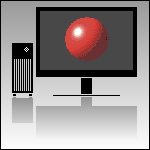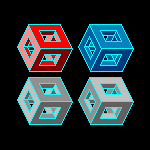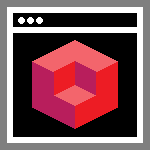Advanced 3D Software
 |
Advanced 3-D Modeling Software
Note the continued improvement in 3-D modeling and animation software. Also note the development of easy to use multimedia editing software tools that enables movies and animations to be produced for and displayed on the Internet. As the processing power of PC’s improves, 3-D modeling software will become more and more popular. Note the increased use of parallel processing and “rendering farms” to produce animations and hyper photo-realistic renderings.
As raw processing power becomes more affordable through miniaturization and the price of memory continues to decline, more and more high performance 3D graphics cards will be built and marketed. When coupled with recent enhancements to desktop rendering and animation software, 3-D visualization will become more commonplace.
The continued popularity of computer games is also powering the development of advanced graphics hardware and software. Game producers are routinely relying on hardware improvements to allow them to design ever more computationally intense games.
Note the merging of 3-D modeling, rendering, animation and physics modeling tools into integrated shrink wrapped packages. As the popularity and availability of very powerful PC’s increases, more and more users will be able to use this type of computationally intense software.
|
 |
Advanced 3-D Kernels
Increased competition continues to drive the development of 3-D kernels. User demands for increased interoperability between 3-D models are tending to homogenize 3-D software and files formats.
|
 |
3D Modeling Meets the Internet
- Note the development of several competing standards that enable 3-D models to be viewed and manipulated on the World Wide Web (e.g. VRML, VML etc.). The capability of viewing 3-D models over the Internet is not new. Existing viewers however require 3-D models to be produced in proprietary file formats. Web pages that use proprietary 3-D models are not readily viewable by the browsing public. If an industry standard were to emerge, users could reasonably expect that their modeling software was capable of producing interchangeable models. 3-D models could be produced with little worry that they wouldn’t be viewable on the web.
- Expect further development of web based programming languages (like VRML – short for Virtual Reality Modeling Language) that enhance the streamline the delivery of 3D models over the internet. Several vendors are collectively developing a variant of the XML (eXtensible Markup Language) programming language to allow greater flexibility in the design and delivery of 3D models over the web. Expect a countervailing trend for some software manufacturers to develop proprietary methods of doing the same thing. The open versus closed approach to 3D modeling has a direct bearing on architects in that we will soon be forced to select a method of delivering 3D models to our clients or to other members of project teams. The method we choose must be flexible enough to satisfy the demands placed on us by our clients, our competitors or other members of our project teams (most notably contractors).
|
(Previous Page)(Next Page)